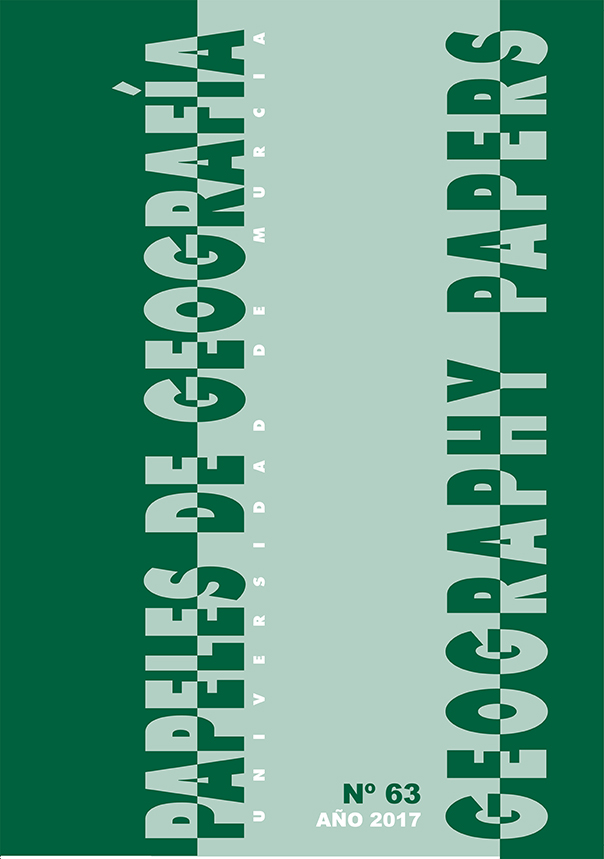Una metodología multivariante versus una metodología tradicional en la identificación y clasificación del paisaje
Resumen
El objetivo de este estudio ha sido validar una identificación de tipos de paisaje desarrollada gracias a un método multivariante de clasificación (TWINSPAN), tomando como ámbito de estudio la provincia de Huelva (Andalucía, España), mediante su comparación con una identificación realizada utilizando métodos no estadísticos. Para ello se eligió la identificación de tipos de paisajes del Atlas de los Paisajes de España Sanz. El análisis comparado muestra un grado de similitud óptimo entre ambas. Esto respalda la validez del método multivariante, que además presenta una serie de ventajas frente al tradicional, aunque probablemente la excelencia se consiga mediante la combinación de ambosDescargas
-
Resumen383
-
PDF503
-
PDF 503
Citas
ALCÁNTARA, J. A., & MUÑOZ, J. M. (2015). Estudios geográficos. “Landscape classification of Huelva (Spain): An objective method of identification and characterization”, vol. 76, nº. 279, p. 447-471.
BLANKSON, E. J., & GREEN, B. H. (1991). Landscape and Urban planning. “Use of landscape classification as an essential prerequisite to landscape evaluation”, vol. 21, nº 3, p. 149-162.
BUNCE, R. G. H., BARR, C. J., & WHITTAKER, H. A. (1981). Annual report of the institute of terrestrial ecology. “An integrated system of land classification”, vol. 1980, 28-33.
BUNCE, R. G. H., & HEAL, O. W. (1984). Planning and Ecology. “Landscape evaluation and the impact of changing Land-Use on the rural environment. The problem and an approach”. En ROBERTS, RD & ROBERTS, TM. (Ed). Chapman & Hall. Londres & Nueva York.
BUNCE, R. G. H., CLARIDGE, C. J., BARR, C. J., & BALDWIN, M. B. (1986). Land and its Uses—actual and potential. “An ecological classification of land-its application to planning in the Highland Region, Scotland”. Springer. US, pp. 407-426.
BUNCE, R. G. H., BARR, C. J., CLARKE, R. T., HOWARD, D. C., & LANE, A. M. J. (1996). Journal of biogeography. “ITE Merlewood land classification of Great Britain”, vol. 23, nº 5, p. 625-634.
BUNCE, R. G. H., CAREY, P. D., ELENA-ROSSELLO, R., ORR, J., WATKINS, J., & FULLER, R. (2002). Journal of environmental management. “A comparison of different biogeographical classifications of Europe, Great Britain and Spain”, vol. 65, nº 2, p. 121-134.
CHERRILL, A. (1994). Journal of Rural Studies. “A comparison of three landscape classifications and investigation of the potential for using remotely sensed land cover data for landscape classification”, vol. 10, nº 3, p. 275-289.
CHUMAN, T., & ROMPORTL, D. (2010). Landscape and Urban Planning. “Multivariate classification analysis of cultural landscapes: An example from the Czech Republic”, vol. 98, nº 3, p. 200-209.
CLARIDGE, C. J. (1989). Rural Information for Forward Planning. “The approach adopted by Highland Regional Council", p. 21-28.
COUNTRYSIDE COMMISSION. (1987). CCD. “Landscape assessment: a Countryside Commission approach”, p. 18.
ENGLISH NATURE (1993). Strategy for the 1990s: Natural Areas. English Nature. Peterborough.
FORMAN, R. T. T., & GODRON, M. (1986). Landscape Ecology. John Wiley& Sons. New York, 619 pp.
FOODY, G. M. (2002). Remote sensing of environment. “Status of land cover classification accuracy assessment”, vol. 80, nº 1, p. 185-201.
HABERMAN, S. J. (1978). Analysis of Quantitative Data. Volume 1 Introductory Topics.
HAGEN-ZANKER, A. (2006). Journal of Geographical Systems. “Map comparison methods that simultaneously address overlap and structure”, vol. 8, nº 2, p. 165-185.
HAINES-YOUNG, R.H. (1992): Landscape ecology in Britain, Proceedings of the first international associations of landscape ecology-UK meeting. “Landscape ecology and the countryside information system”. En Haines-Young, R. (Ed.). University of Nottingham. Nottingham.
KENT, M. & COKER, M. (1992): Vegetation Description and Analysis. A Practical Approach. CRC Press, Inc., Corporate Blvd. Florida.
LEGENDRE, P., & LEGENDRE, L. (1998). Numerical Ecology, Volume 24, (Developments in Environmental Modelling).
MOREIRA, J. M. (2003): Geografía de Andalucía. “El relieve y las costas andaluzas I. Las grandes unidades del relieve andaluz”. En López Ontiveros, A. (Coord.). Ariel Geografía. Barcelona.
MOSS, D. (1985). Applied Geography. “An initial classification of 10-km squares in Great Britain from a land characteristic data bank”, vol. 5, nº 2, p. 131-150.
PITA LÓPEZ, M. F. (2003): Geografía de Andalucía. “El clima de Andalucía”. En López Ontiveros, A. (Coord.). Ariel Geografía. Barcelona.
SANZ HERRÁIZ, C., MATA OLMO, R., GÓMEZ MENDOZA, J., ALLENDE ÁLVAREZ, F., LÓPEZ ESTÉBANEZ, N., MOLINA HOLGADO, P. AND GALIANA MARTÍN, M. (2003). Atlas de los Paisajes de España. Centro de Publicaciones. Secretaria General Técnica. Ministerio de Medio Ambiente. Madrid.
Las obras que se publican en esta revista están sujetas a los siguientes términos:
1. El Servicio de Publicaciones de la Universidad de Murcia (la editorial) conserva los derechos patrimoniales (copyright) de las obras publicadas, y favorece y permite la reutilización de las mismas bajo la licencia de uso indicada en el punto 2.
2. Las obras se publican en la edición electrónica de la revista bajo una licencia Creative Commons Reconocimiento-NoComercial 4.0 (texto legal). Se pueden copiar, usar, difundir, transmitir y exponer públicamente, siempre que: i) se cite la autoría y la fuente original de su publicación (revista, editorial y URL de la obra); ii) no se usen para fines comerciales; iii) se mencione la existencia y especificaciones de esta licencia de uso.
3. Condiciones de auto-archivo. Se permite y se anima a los autores a difundir electrónicamente las versiones pre-print (versión antes de ser evaluada) y/o post-print (versión evaluada y aceptada para su publicación) de sus obras antes de su publicación, ya que favorece su circulación y difusión más temprana y con ello un posible aumento en su citación y alcance entre la comunidad académica. Color RoMEO: verde.








